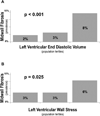Left ventricular geometric remodeling in relation to non-ischemic scar pattern on cardiac magnetic resonance imaging
- PMID: 25008088
- PMCID: PMC4233172
- DOI: 10.1007/s10554-014-0487-8
Left ventricular geometric remodeling in relation to non-ischemic scar pattern on cardiac magnetic resonance imaging
Abstract
Left ventricular (LV) remodeling and myocardial fibrosis have been linked to adverse heart failure outcomes. Mid wall late gadolinium enhancement (MW-LGE) on cardiac magnetic resonance (CMR) imaging is well-associated with non-ischemic cardiomyopathy (NICM), but prevalence in ischemic cardiomyopathy (ICM) and association with remodeling are unknown. The population comprised patients with systolic dysfunction [LV ejection fraction (LVEF ≤ 40 %)]. CMR was used to identify MW-LGE, conventionally defined as fibrosis of the mid-myocardial or epicardial aspect of the LV septum. 285 patients were studied. MW-LGE was present in 12 %, and was tenfold more common with NICM (32 %) versus ICM (3 %, p < 0.001). However, owing to higher prevalence of ICM, 15 % of patients with MW-LGE had ICM. LV wall stress was higher (p = 0.02) among patients with, versus those without, MW-LGE despite similar systolic blood pressure (p = 0.24). In multivariate analysis, MW-LGE was associated with CMR-quantified LV end-diastolic volume (p = 0.03) independent of LVEF and mass. Incorporation of clinical and imaging variables demonstrated MW-LGE to be associated with higher LV end-diastolic volume (OR 1.13, CI 1.004-1.27 per 10 ml/m(2), p = 0.04) after controlling for presence of NICM (OR 16.0, CI 5.8-44.1, p < 0.001). While more common in NICM, MW-LGE can occur in ICM and is a marker of LV chamber dilation irrespective of cardiomyopathic etiology.
Conflict of interest statement
Figures



Comment in
-
Mystery of myocardial midwall late enhancement?Int J Cardiovasc Imaging. 2014 Dec;30(8):1569-70. doi: 10.1007/s10554-014-0514-9. Epub 2014 Aug 13. Int J Cardiovasc Imaging. 2014. PMID: 25117644 No abstract available.
Similar articles
-
Myocardial fibrosis as a key determinant of left ventricular remodeling in idiopathic dilated cardiomyopathy: a contrast-enhanced cardiovascular magnetic study.Circ Cardiovasc Imaging. 2013 Sep;6(5):790-9. doi: 10.1161/CIRCIMAGING.113.000438. Epub 2013 Aug 9. Circ Cardiovasc Imaging. 2013. PMID: 23934992
-
Myocardial Fibrosis Assessment by LGE Is a Powerful Predictor of Ventricular Tachyarrhythmias in Ischemic and Nonischemic LV Dysfunction: A Meta-Analysis.JACC Cardiovasc Imaging. 2016 Sep;9(9):1046-1055. doi: 10.1016/j.jcmg.2016.01.033. Epub 2016 Jul 20. JACC Cardiovasc Imaging. 2016. PMID: 27450871 Review.
-
The impact of infarct size on regional and global left ventricular systolic function: a cardiac magnetic resonance imaging study.Int J Cardiovasc Imaging. 2015 Jun;31(5):1037-44. doi: 10.1007/s10554-015-0657-3. Epub 2015 Apr 12. Int J Cardiovasc Imaging. 2015. PMID: 25863669
-
Late gadolinium enhancement from cardiac magnetic resonance in ischemic and non-ischemic cardiomyopathy.J Med Assoc Thai. 2011 Feb;94 Suppl 1:S33-8. J Med Assoc Thai. 2011. PMID: 21721426
-
Prognostic Value of Cardiac MRI Late Gadolinium Enhancement in Patients with Peripartum Cardiomyopathy: A Retrospective Study.Curr Probl Cardiol. 2023 Apr;48(4):101587. doi: 10.1016/j.cpcardiol.2023.101587. Epub 2023 Jan 9. Curr Probl Cardiol. 2023. PMID: 36634831 Review.
Cited by
-
Muscle Matters: CMR Tissue Characterization for Mechanistically Tailored Risk Stratification of Functional Mitral Regurgitation.Circ Cardiovasc Imaging. 2023 Aug;16(8):e015808. doi: 10.1161/CIRCIMAGING.123.015808. Epub 2023 Jul 28. Circ Cardiovasc Imaging. 2023. PMID: 37503590 Free PMC article. No abstract available.
-
Role of cardiovascular magnetic resonance in the clinical evaluation of left ventricular hypertrophy: a 360° panorama.Int J Cardiovasc Imaging. 2023 Apr;39(4):793-809. doi: 10.1007/s10554-022-02774-x. Epub 2022 Dec 21. Int J Cardiovasc Imaging. 2023. PMID: 36543912 Review.
-
Abnormal Mechanics Relate to Myocardial Fibrosis and Ventricular Arrhythmias in Patients With Mitral Valve Prolapse.Circ Cardiovasc Imaging. 2023 Apr;16(4):e014963. doi: 10.1161/CIRCIMAGING.122.014963. Epub 2023 Apr 18. Circ Cardiovasc Imaging. 2023. PMID: 37071717 Free PMC article.
-
Cardiovascular imaging 2014 in the International Journal of Cardiovascular Imaging.Int J Cardiovasc Imaging. 2015 Mar;31(3):447-61. doi: 10.1007/s10554-015-0627-9. Int J Cardiovasc Imaging. 2015. PMID: 25969848 Review. No abstract available.
-
Beneficial Effects of Mineralocorticoid Receptor Antagonism on Myocardial Fibrosis in an Experimental Model of the Myxomatous Degeneration of the Mitral Valve.Int J Mol Sci. 2020 Jul 28;21(15):5372. doi: 10.3390/ijms21155372. Int J Mol Sci. 2020. PMID: 32731636 Free PMC article.
References
-
- Migrino RQ, Young JB, Ellis SG, White HD, Lundergan CF, Miller DP, et al. End-systolic volume index at 90 to 180 minutes into reperfusion therapy for acute myocardial infarction is a strong predictor of early and late mortality. The Global Utilization of Streptokinase and t-PA for Occluded Coronary Arteries (GUSTO)-I Angiographic Investigators. Circulation. 1997;96:116–121. - PubMed
-
- Lee TH, Hamilton MA, Stevenson LW, Moriguchi JD, Fonarow GC, Child JS, et al. Impact of left ventricular cavity size on survival in advanced heart failure. Am J Cardiol. 1993;72:672–676. - PubMed
-
- Pfeffer MA, Braunwald E, Moyé LA, Basta L, Brown EJ, Cuddy TE, et al. Effect of captopril on mortality and morbidity in patients with left ventricular dysfunction after myocardial infarction. Results of the survival and ventricular enlargement trial. The SAVE Investigators. N Engl J Med. 1992;327:669–677. - PubMed
-
- Sadoshima J, Xu Y, Slayter HS, Izumo S. Autocrine release of angiotensin II mediates stretch-induced hypertrophy of cardiac myocytes in vitro. Cell. 1993;75:977–984. - PubMed
-
- Harada K, Sugaya T, Murakami K, Yazaki Y, Komuro I. Angiotensin II type 1A receptor knockout mice display less left ventricular remodeling and improved survival after myocardial infarction. Circulation. 1999;100:2093–2099. - PubMed
Publication types
MeSH terms
Substances
Grants and funding
LinkOut - more resources
Full Text Sources
Other Literature Sources
Medical

